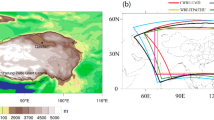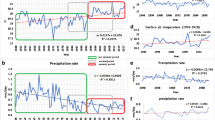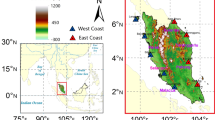Abstract
It was evident from observations in the recent past that atmospheric variables are changing at regional scale and may continue to impact the regional weather in the coming future. An 8-member ensemble from the HighResMIP experiment is used to analyze projected changes in temperature, atmospheric pressure, precipitation, and surface wind over Iran during 2015–2050 period. A considerable increase of temperature between 2 and 2.5 °C by 2050 with respect to the baseline period (1979–2014) is expected with a higher rate towards southwestern and southeastern of Iran. From the seasonal analysis, an increase of ~ 4 °C (2 °C) by 2050 would be maintained in summer (winter) season over the country. Furthermore, a reduction in atmospheric pressure between 0.2 and 1 hPa by 2050 with respect to the baseline period towards the northwestern region of the country is foresaw; however, no consistent changes are expected in the remain regions where lack of coherence between models is recognized. Besides, precipitation changes are expected to be significant towards the northwestern Iran region with values between 0.1 and 0.3 mm day−1 by 2050 with respect to the baseline period, contrary to the results obtained in the eastern region with changes between − 0.1 and 0.1 mm day−1 towards the Lut and the Kavir deserts. Additionally, an interesting behavior was noticeable in all the models selected with a reduction in precipitation of 0.3 mm day−1 between June and September which announce temperature increases principally in boreal summer, thus can exacerbate extensive droughts in different regions of Iran. Finally, surface wind speed and direction behavior were assessed, showing an increase of surface wind speed between 0.05 and 0.1 ms−1, but no significant trends were observed in the majority of the country similar to expected changes in wind direction.












Similar content being viewed by others
Data availability
The datasets used and/or analyzed during the current study available from the corresponding author on reasonable request.
References
Abbasian M, Moghim S, Abrishamchi A (2019) Performance of the general circulation models in simulating temperature and precipitation over Iran. Theor Appl Climatol 135:1465–1483
Abbaspour KC, Faramarzi M, Ghasemi SS, Yang H (2009) Assessing the impact of climate change on water resources in Iran. Water Resour Res 45:
Alamdari P, Nematollahi O, Mirhosseini M (2012) Assessment of wind energy in Iran: a review. Renew Sustain Energy Rev 16:836–860. https://doi.org/10.1016/j.rser.2011.09.007
Ali S, Liu Y, Ishaq M et al (2017) Climate change and its impact on the yield of major food crops: evidence from Pakistan. Foods Basel Switz 6:39. https://doi.org/10.3390/foods6060039
Alijani B, Ghohroudi M, Arabi N (2008) Developing a climate model for Iran using GIS. Theor Appl Climatol 92:103–112. https://doi.org/10.1007/s00704-006-0292-y
Almazroui M, Saeed S, Saeed F et al (2020) Projections of precipitation and temperature over the South Asian Countries in CMIP6. Earth Syst Environ 4:297–320. https://doi.org/10.1007/s41748-020-00157-7
Azari M, Oliaye A, Nearing MA (2021) Expected climate change impacts on rainfall erosivity over Iran based on CMIP5 climate models. J Hydrol 593:125826. https://doi.org/10.1016/j.jhydrol.2020.125826
babaeian iman, karimian maryam, modirian rahele, mirzaei E (2019) Future climate change projection over Iran using CMIP5 data during 2020–2100. Nivar 43:62–71. https://doi.org/10.30467/nivar.2019.142745.1103
Babar Z, Zhi X, Ge F et al (2016) Assessment of Southwest Asia surface temperature changes: CMIP5 20th and 21st Century Simulations. PAKISTAN JOURNAL OF METEOROLOGY 13:15–27
Chen Z, Zhou T, Zhang L, et al (2020) Global land monsoon precipitation changes in CMIP6 projections. Geophys Res Lett 47:e2019GL086902. https://doi.org/10.1029/2019GL086902
Copsey D, Sutton R, Knight JR (2006) Recent trends in sea level pressure in the Indian Ocean region. Geophys Res Lett 33:. https://doi.org/10.1029/2006GL027175
Cucchi M, Weedon G, Amici A, et al (2020) WFDE5: bias adjusted ERA5 reanalysis data for impact studies. 10.5194/essd-12-2097-2020
da Costa GM, Alves DD, Martins DP, et al (2022) Climate changes and atmospheric pollution: global and regional impacts. In: Research Anthology on Environmental and Societal Impacts of Climate Change. IGI Global, pp 540–577
dadashi-rodbari abbasali, Salehabadi N (2020) Projected temperature anomalies and trends in different climatic zones in Iran based on CMIP6. Iran J Geophys. https://doi.org/10.30499/ijg.2020.249997.1292
Dawson A, Palmer TN, Corti S (2012) Simulating regime structures in weather and climate prediction models. Geophys Res Lett 39:
Demory M-E, Vidale PL, Roberts MJ et al (2014) The role of horizontal resolution in simulating drivers of the global hydrological cycle. Clim Dyn 42:2201–2225. https://doi.org/10.1007/s00382-013-1924-4
Doi T, Vecchi GA, Rosati AJ, Delworth TL (2012) Biases in the Atlantic ITCZ in seasonal–interannual variations for a coarse- and a high-resolution coupled climate model. J Clim 25:5494–5511. https://doi.org/10.1175/JCLI-D-11-00360.1
Doulabian S, Golian S, Toosi AS, Murphy C (2020) Evaluating the effects of climate change on precipitation and temperature for Iran using RCP scenarios. J Water Clim Change. https://doi.org/10.2166/wcc.2020.114
Fallah-Ghalhari G, Shakeri F, Dadashi-Roudbari A (2019) Impacts of climate changes on the maximum and minimum temperature in Iran. Theor Appl Climatol 138:1539–1562. https://doi.org/10.1007/s00704-019-02906-9
Flaounas E, Drobinski P, Bastin S (2013) Dynamical downscaling of IPSL-CM5 CMIP5 historical simulations over the Mediterranean: benefits on the representation of regional surface winds and cyclogenesis. Clim Dyn 40:2497–2513. https://doi.org/10.1007/s00382-012-1606-7
Ghasemi A, Khalili D (2008) The association between regional and global atmospheric patterns and winter precipitation in Iran. Atmospheric Res - ATMOS RES 88:116–133. https://doi.org/10.1016/j.atmosres.2007.10.009
Haarsma RJ, Roberts MJ, Vidale PL et al (2016) High Resolution Model Intercomparison Project (HighResMIP v1.0) for CMIP6. Geosci Model Dev 9:4185–4208. https://doi.org/10.5194/gmd-9-4185-2016
Hashemi H, Uvo CB, Berndtsson R (2015) Coupled modeling approach to assess climate change impacts on groundwater recharge and adaptation in arid areas. Hydrol Earth Syst Sci 19:4165–4181
Hodges KI, Lee RW, Bengtsson L (2011) A Comparison of Extratropical Cyclones in Recent Reanalyses ERA-Interim, NASA MERRA, NCEP CFSR, and JRA-25. J Clim 24:4888–4906. https://doi.org/10.1175/2011JCLI4097.1
IPCC (2021) The Physical Science Basis. Contribution of Working Group I to the Sixth Assessment Report of the Intergovernmental Panel on Climate Change
IPCC (2014) Climate Change 2014: Synthesis Report. Switzerland, Geneva
Javadinejad S, Eslamian S, Ostad-Ali-Askari K (2021) The analysis of the most important climatic parameters affecting performance of crop variability in a changing climate. Int J Hydrol Sci Technol 11:1. https://doi.org/10.1504/IJHST.2021.112651
Javadinejad S, Ostad-Ali-Askari K, Jafary F (2019) Using simulation model to determine the regulation and to optimize the quantity of chlorine injection in water distribution networks. Model Earth Syst Environ 5:1015–1023. https://doi.org/10.1007/s40808-019-00587-x
Jiang D, Tian Z (2013) East Asian monsoon change for the 21st century: Results of CMIP3 and CMIP5 models. Chin Sci Bull 58:1427–1435. https://doi.org/10.1007/s11434-012-5533-0
Kapnick SB, Delworth TL (2013) Controls of global snow under a changed climate. J Clim 26:5537–5562. https://doi.org/10.1175/JCLI-D-12-00528.1
Katiraie-Boroujerdy P-S, Akbari Asanjan A, Chavoshian A et al (2019) Assessment of seven CMIP5 model precipitation extremes over Iran based on a satellite-based climate data set. Int J Climatol 39:3505–3522. https://doi.org/10.1002/joc.6035
Khazaei MR, Zahabiyoun B, Saghafian B (2012) Assessment of climate change impact on floods using weather generator and continuous rainfall-runoff model. Int J Climatol 32:1997–2006
Li R, Lv S, Han B et al (2017) Projections of South Asian summer monsoon precipitation based on 12 CMIP5 models. Int J Climatol 37:94–108. https://doi.org/10.1002/joc.4689
Maghsood FF, Moradi H, Bavani AR et al (2019) Climate change impact on flood frequency and source area in Northern Iran under CMIP5 Scenarios. Water 11:22
Mansouri Daneshvar MR, Ebrahimi M, Nejadsoleymani H (2019) An overview of climate change in Iran: facts and statistics. Environ Syst Res 8:7. https://doi.org/10.1186/s40068-019-0135-3
Masson S, Terray P, Madec G et al (2012) Impact of intra-daily SST variability on ENSO characteristics in a coupled model. Clim Dyn 39:681–707. https://doi.org/10.1007/s00382-011-1247-2
Mojgan GM, Mehdi MM, Reza BM (2017) The trend of changes in surface wind in the Indian Ocean, in the Period from 1981 to 2015, using reanalysis data, NCEP/NCAR. Open J. Mar. Sci. Vol.07No.04:14
Mousavi A, Ardalan A, Takian A et al (2020) Climate change and health in Iran: a narrative review. J Environ Health Sci Eng 18:367–378. https://doi.org/10.1007/s40201-020-00462-3
Nafchi RF, Yaghoobi P, Vanani HR, et al (2022) Eco-hydrologic stability zonation of dams and power plants using the combined models of SMCE and CEQUALW2 (vol 11, pg 109, 2021). Appl WATER Sci 12:
O’Neill BC, Tebaldi C, van Vuuren DP et al (2016) The Scenario Model Intercomparison Project (ScenarioMIP) for CMIP6. Geosci Model Dev 9:3461–3482. https://doi.org/10.5194/gmd-9-3461-2016
Ostad-Ali-Askari K, Ghorbanizadeh Kharazi H, Shayannejad M, Zareian MJ (2019) Effect of management strategies on reducing negative impacts of climate change on water resources of the Isfahan-Borkhar aquifer using MODFLOW. River Res Appl 35:611–631. https://doi.org/10.1002/rra.3463
Ostad-Ali-Askari K, Shayan M (2021) Subsurface drain spacing in the unsteady conditions by HYDRUS-3D and artificial neural networks. Arab J Geosci 14:1936. https://doi.org/10.1007/s12517-021-08336-0
Ostad-Ali-Askari K, Shayannejad M (2021) Quantity and quality modelling of groundwater to manage water resources in Isfahan-Borkhar Aquifer. Environ Dev Sustain 23:15943–15959. https://doi.org/10.1007/s10668-021-01323-1
Kaveh O-A-A, Hossein GK, Mohammad S, Javad ZM (2020) Effect of climate change on precipitation patterns in an arid region using GCM models: case study of Isfahan-Borkhar Plain. Nat Hazards Rev 21:04020006. https://doi.org/10.1061/(ASCE)NH.1527-6996.0000367
Paul A, Kaviani A, Hatzfeld D et al (2006) Seismological evidence for crustal-scale thrusting in the Zagros mountain belt (Iran). Geophys J Int 166:227–237. https://doi.org/10.1111/j.1365-246X.2006.02920.x
Popp A, Calvin K, Fujimori S et al (2017) Land-use futures in the shared socio-economic pathways. Glob Environ Change 42:331–345. https://doi.org/10.1016/j.gloenvcha.2016.10.002
Pourshirazi S, Soltani A, Zeinali E, et al (2022) Assessing the sensitivity of alfalfa yield potential to climate impact under future scenarios in Iran. Environ Sci Pollut Res 1–14
Rahimi J, Laux P, Khalili A (2020a) Assessment of climate change over Iran: CMIP5 results and their presentation in terms of Köppen-Geiger climate zones. Theor Appl Climatol 141:183–199
Raziei T, Saghafian B, Paulo A et al (2009) Spatial patterns and temporal variability of drought in Western Iran. Water Resour Manag 23:439–455. https://doi.org/10.1007/s11269-008-9282-4
Roberts M (2017a) MOHC HadGEM3-GC31-MM model output prepared for CMIP6 HighResMIP
Roberts M (2017b) MOHC HadGEM3-GC31-HM model output prepared for CMIP6 HighResMIP
Roberts M (2018) MOHC HadGEM3-GC31-HH model output prepared for CMIP6 HighResMIP
Roberts MJ, Clayton A, Demory M-E et al (2009) Impact of Resolution on the Tropical Pacific Circulation in a Matrix of Coupled Models. J Clim 22:2541–2556. https://doi.org/10.1175/2008JCLI2537.1
Sabziparvar AA, Movahedi S, Asakereh H et al (2015) Geographical factors affecting variability of precipitation regime in Iran. Theor Appl Climatol 120:367–376. https://doi.org/10.1007/s00704-014-1174-3
Samadi S, Carbone GJ, Mahdavi M et al (2012) Statistical downscaling of climate data to estimate streamflow in a semi-arid catchment. Hydrol Earth Syst Sci Discuss 9:4869–4918
Sayari N, Bannayan M, Alizadeh A, Farid A (2013) Using drought indices to assess climate change impacts on drought conditions in the northeast of Iran (case study: Kashafrood basin). Meteorol Appl 20:115–127
Scoccimarro E, Bellucci A, Peano D (2019) CMCC CMCC-CM2-HR4 model output prepared for CMIP6 HighResMIP hist-1950
Scoccimarro E, Bellucci A, Peano D (2017) CMCC CMCC-CM2-VHR4 model output prepared for CMIP6 HighResMIP
Shadkam S, Ludwig F, van Vliet MTH et al (2016) Preserving the world second largest hypersaline lake under future irrigation and climate change. Sci Total Environ 559:317–325
Shaffrey LC, Stevens I, Norton WA et al (2009) U.K. HiGEM: the new U.K. high-resolution global environment model—model description and basic evaluation. J Clim 22:1861–1896. https://doi.org/10.1175/2008JCLI2508.1
Shifteh Some’e B, Ezani A, Tabari H, (2012) Spatiotemporal trends and change point of precipitation in Iran. Atmospheric Res 113:1–12. https://doi.org/10.1016/j.atmosres.2012.04.016
Sivakumar M, Stefanski R (2011) Climate Change in South Asia. pp 13–30
Soltani M, Laux P, Kunstmann H et al (2016) Assessment of climate variations in temperature and precipitation extreme events over Iran. Theor Appl Climatol 126:775–795. https://doi.org/10.1007/s00704-015-1609-5
Stocklin J (1974) Possible Ancient Continental Margins in Iran. In: Burk C.A., Drake C.L. (eds) The Geology of Continental Margins. Springer, Berlin
Tabari H, Talaee PH (2011) Temporal variability of precipitation over Iran: 1966–2005. J Hydrol 396:313–320. https://doi.org/10.1016/j.jhydrol.2010.11.034
Tozer B, Sandwell DT, Smith WHF et al (2019) Global bathymetry and topography at 15 Arc Sec: SRTM15+. Earth Space Sci 6:1847–1864. https://doi.org/10.1029/2019EA000658
UNFCC (2014) THIRD NATIONAL COMMUNICATION ON CLIMATE CHANGE
Usta DFB, Teymouri M, Chatterjee U (2022) Assessment of temperature changes over Iran during the twenty-first century using CMIP6 models under SSP1–26, SSP2–4.5, and SSP5–8.5 scenarios. Arab J Geosci 15:416. https://doi.org/10.1007/s12517-022-09709-9
Usta DFB, Teymouri M, Chatterjee U, Koley B (2021) Temperature projections over Iran during the twenty-first century using CMIP5 models. Model Earth Syst Environ. https://doi.org/10.1007/s40808-021-01115-6
von Storch J-S, Putrasahan D, Lohmann K, et al (2017a) MPI-M MPI-ESM1.2-XR model output prepared for CMIP6 HighResMIP
von Storch J-S, Putrasahan D, Lohmann K, et al (2017b) MPI-M MPIESM1.2-HR model output prepared for CMIP6 HighResMIP
Wood AW, Maurer EP, Kumar A, Lettenmaier DP (2002) Long-range experimental hydrologic forecasting for the eastern United States. J Geophys Res Atmospheres 107:ACL 6–1-ACL 6–15. https://doi.org/10.1029/2001JD000659
Zarenistanak M (2019) Historical trend analysis and future projections of precipitation from CMIP5 models in the Alborz mountain area. Iran Meteorol Atmospheric Phys 131:1259–1280
Acknowledgements
We thank the two anonymous reviewers who allowed us to improve the quality of this paper.
Author information
Authors and Affiliations
Contributions
All authors have contributed equally to this work.
Corresponding author
Ethics declarations
Informed consent
Informed consent was obtained from all individual participants included in the study.
Conflict of interest
The authors declare no competing interests.
Additional information
Responsible Editor: Zhihua Zhang
Springer Nature or its licensor holds exclusive rights to this article under a publishing agreement with the author(s) or other rightsholder(s); author self-archiving of the accepted manuscript version of this article is solely governed by the terms of such publishing agreement and applicable law.
Rights and permissions
Springer Nature or its licensor holds exclusive rights to this article under a publishing agreement with the author(s) or other rightsholder(s); author self-archiving of the accepted manuscript version of this article is solely governed by the terms of such publishing agreement and applicable law.
About this article
Cite this article
Usta, D.F.B., Teymouri, M., Chatterjee, U. et al. Projections of atmospheric changes over Iran in 2014–2050 using the CMIP6-HighResMIP experiment. Arab J Geosci 15, 1335 (2022). https://doi.org/10.1007/s12517-022-10639-9
Received:
Accepted:
Published:
DOI: https://doi.org/10.1007/s12517-022-10639-9




